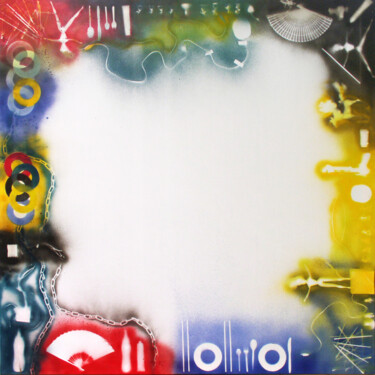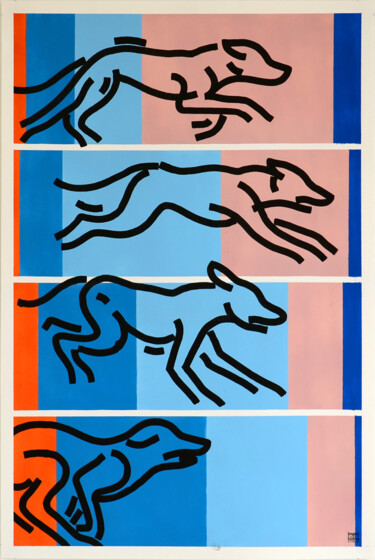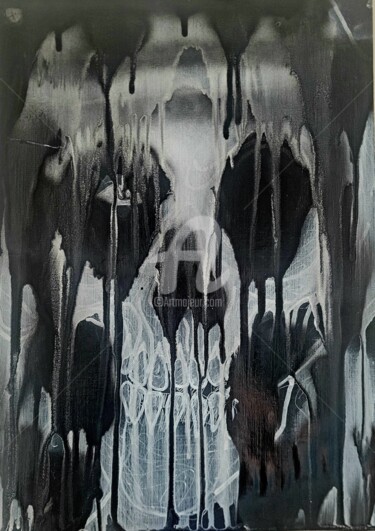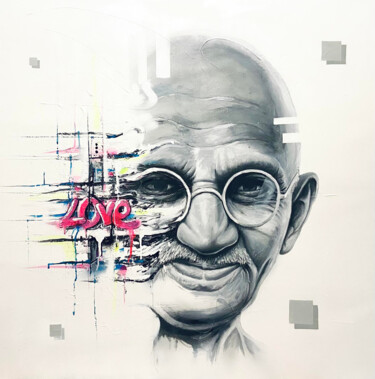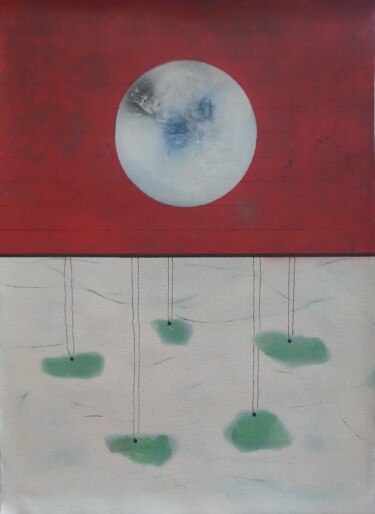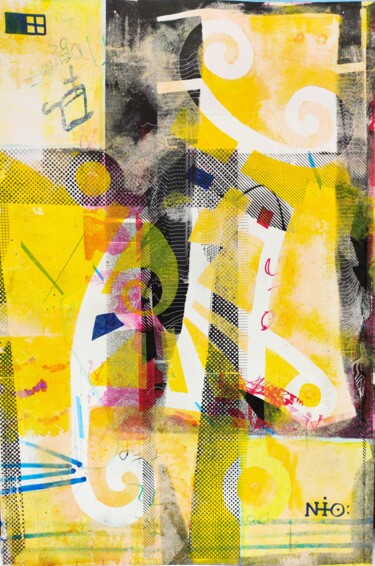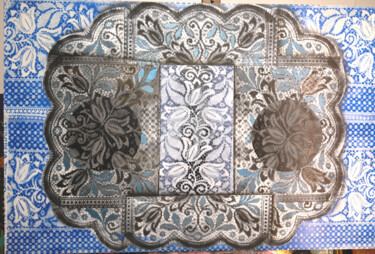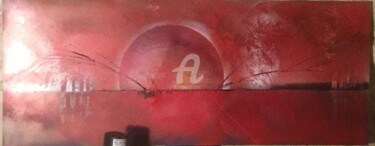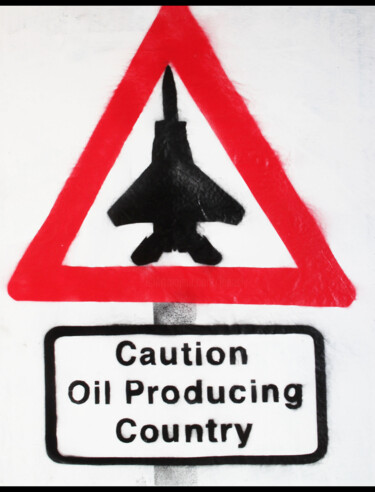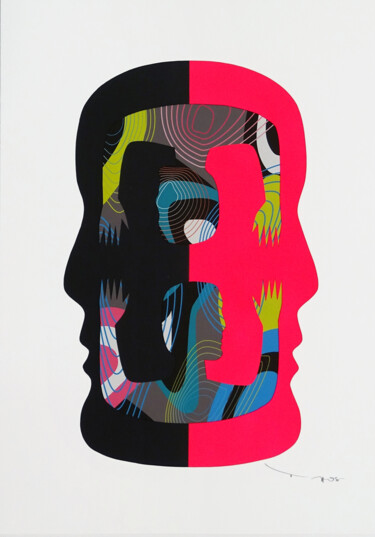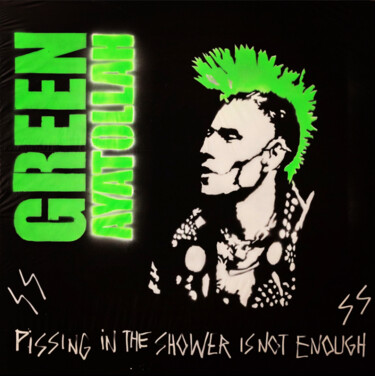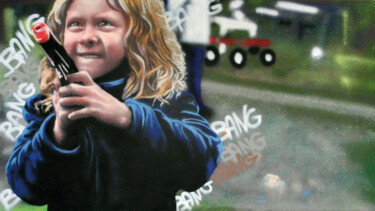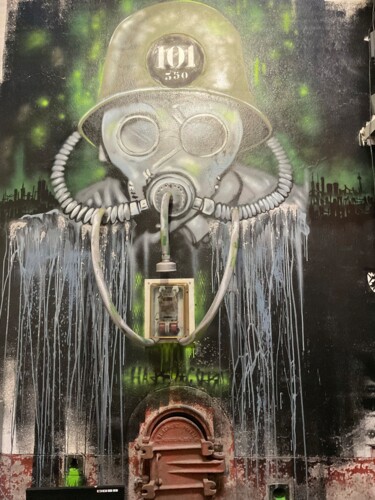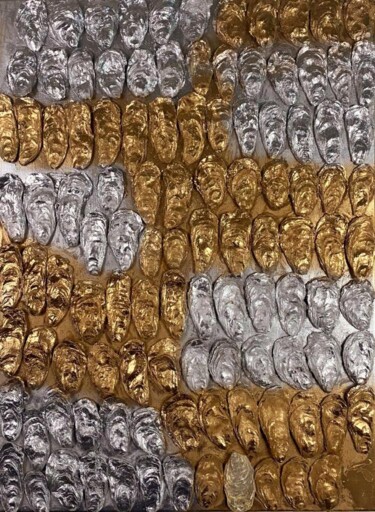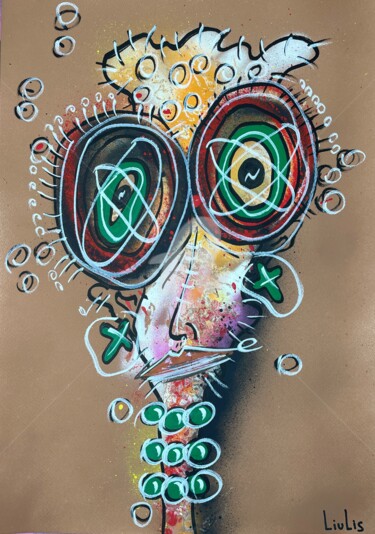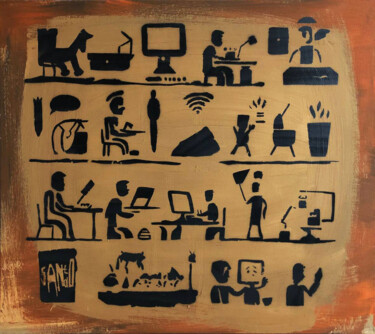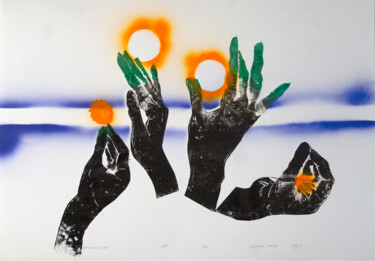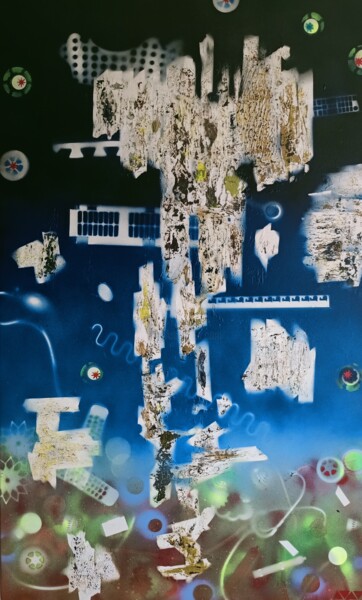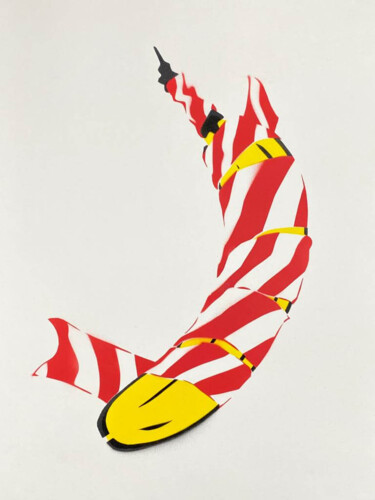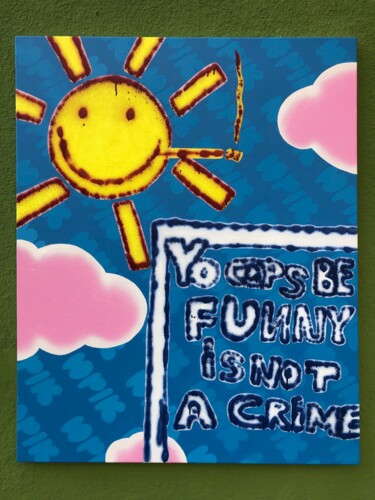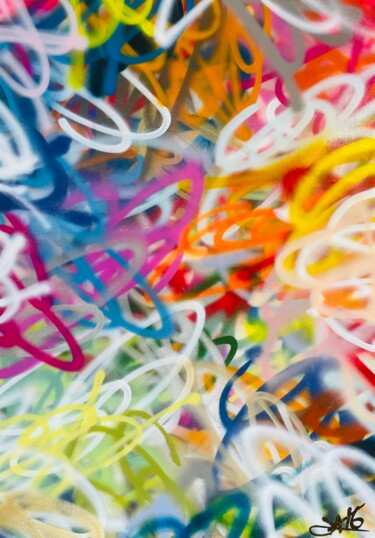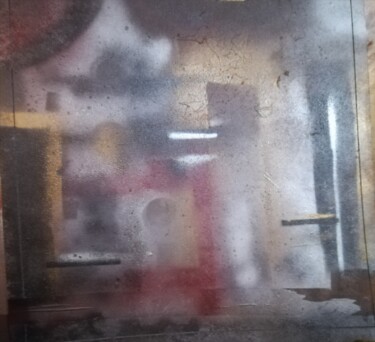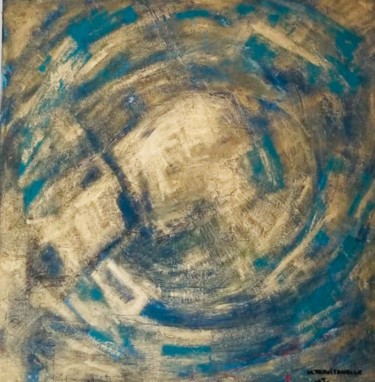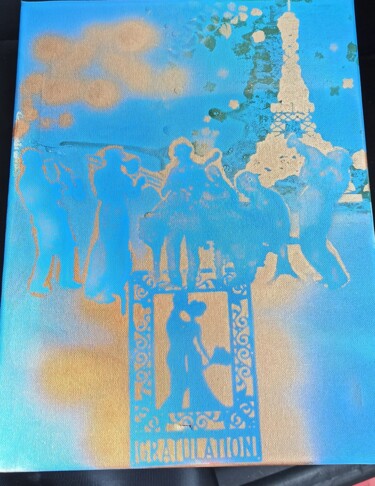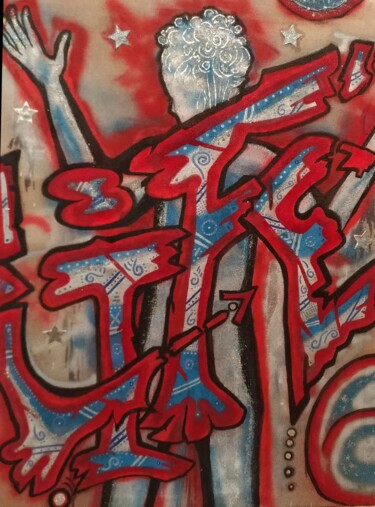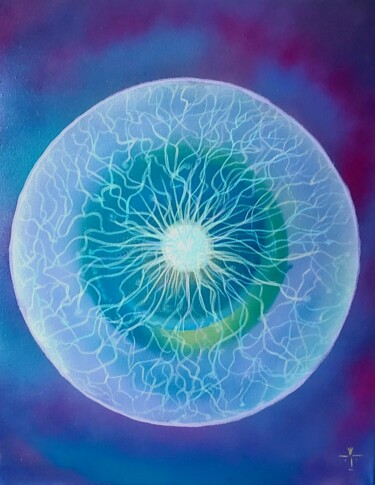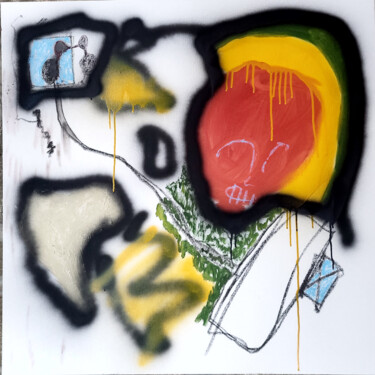48 Originalgemälde zu verkaufen:
Was ist der Ursprung der Sprühfarbe Technik?
Gemälde auf verschiedenen Trägern (Wandleinwand) mit einer Mischung aus Farbe und Gas, die in einem Behälter (Aerosoldose) eingeschlossen ist. Durch das ausgestoßene Gas kann die Farbe verdampft werden. Sprühfarbe und Graffiti wurden Ende der 1980er Jahre in der künstlerischen Welt und genauer im Bereich der Street-Art populär. Diese unzähligen Schriftzüge und Farbverläufe werden fast systematisch mit einer Sprühfarbe (oder Aerosolspray) hergestellt. Sprühfarbe wird meist mit Schablonen aufgetragen und bietet eine sofort erkennbare künstlerische Wiedergabe. Zu den Malern, die die Sprühtechnik am meisten populär gemacht haben, gehören Banksy, Eduardo Kobra und Tatyana Fazlalizadeh.
Wie definiert man Konzeptkunst Stil ?
What is meant by conceptual paintings?
Conceptual art, also called conceptualism, is art in which the idea or ideas behind the work are more important than the way it looks, how it works, or what it is made of. Some conceptual art pieces, which are sometimes called installations, can be made by anyone who can follow written instructions. The American artist Sol LeWitt's definition of conceptual art, which was one of the first to be published, was based on this method:
In conceptual art, the most important part of the work is the idea or concept behind it. When an artist uses a conceptual style, it means that all of the planning and decisions have been made ahead of time, and the work itself is just a formality. The idea turns into a machine that creates art.
Tony Godfrey, who wrote Conceptual Art (Art & Ideas) in 1998, says that conceptual art questions what art is. This is something that Joseph Kosuth turned into a definition of art in his early manifesto for conceptual art, Art after Philosophy (1969). In the 1950s, the important art critic Clement Greenberg had a strong view of Modern art that included the idea that art should look at itself.
With the rise of language-based art in the 1960s, however, conceptual artists like Art & Language, Joseph Kosuth (who later became the American editor of Art-Language), and Lawrence Weiner began to look at art in a much more radical way than had been possible before (see below). One of the first and most important things they questioned was the idea that an artist's job was to make certain kinds of things.
Because of its association with the Young British Artists and the Turner Prize in the 1990s, "conceptual art" has come to mean all modern art that doesn't use the traditional skills of painting and sculpture. This is especially true in the UK. The fact that the term "conceptual art" is hard to define is one of the reasons why it is now used to describe things that have nothing to do with its original goals and styles.
As the artist Mel Bochner said in 1970 when he talked about why he doesn't like the word "conceptual," it's not always clear what "concept" means, and it could be mistaken for "intention." So, when describing or defining a piece of art as "conceptual," it's important not to mix up what is meant by "conceptual" with the "intention" of the artist.
Conceptual paintings: what is the origin of the term?
Henry Flynt, an artist and philosopher, came up with the term "concept art" in 1961. He did this in an article with the same name that was published in the proto-Fluxus book An Anthology of Chance Operations. He said that Flynt's concept art came from his idea of "cognitive nihilism," in which logical paradoxes are shown to empty ideas of meaning.
Concept art was meant to replace both mathematics and the formalistic music that was popular at the time in serious art music circles. It did this by using the syntax of logic and mathematics. So, Flynt said that for a piece to be called "concept art," it had to be a critique of logic or mathematics that used a linguistic idea as its material. This is something that later "conceptual art" doesn't have.
When Joseph Kosuth and the English Art and Language group used the term, it had a different meaning. They ditched the traditional art object in favor of a documented critical inquiry into the artist's social, philosophical, and psychological status, which began in Art-Language: The Journal of Conceptual Art in 1969.
By the middle of the 1970s, they had done this through books, indices, performances, texts, and paintings. In 1970, Conceptual Art and Conceptual Aspects was held at the New York Cultural Center. It was the first show that was all about conceptual art.
Who were the precursors of conceptual painting?
The French artist Marcel Duchamp helped pave the way for the conceptualists by making works like the readymades that were good examples of conceptual art. The most famous of Duchamp's readymades was Fountain (1917), a standard urinal basin that the artist signed with the pseudonym "R. Mutt" and sent to the Society of Independent Artists in New York for their annual, unjudged show (which rejected it).
In the art world, a common object like a urinal is not considered art because it was not made by an artist or with the intention of being art. It is also not unique or hand-made. Later, US artist Joseph Kosuth wrote in his 1969 essay Art after Philosophy: "All art (after Duchamp) is conceptual (in nature) because art only exists conceptually." He was referring to how important Duchamp's ideas were for future "conceptualists."
Isidore Isou, who started the Lettrism movement in 1956, came up with the idea of a work of art that, by its very nature, could never be made in real life, but could still be appreciated aesthetically by thinking about it.
This idea, which is also called "Art esthapériste" or "infinite-aesthetics," comes from Gottfried Wilhelm Leibniz's "infinitesimals," which are amounts that could not exist except in ideas. Excoordism, the current form of the Isouian movement (as of 2013), calls itself the art of the infinitely large and the infinitely small.
What are the key concepts of conceptual painting?
Conceptual art became a movement in the 1960s, in part as a reaction against formalism, as explained at the time by Clement Greenberg, an important New York art critic. Greenberg said that modern art went through a process of getting smaller and more refined, with the goal of defining the formal, essential nature of each medium. Those things that went against this nature had to be cut back.
For example, the goal of painting was to figure out exactly what a painting is: what makes it a painting and nothing else. As it is the nature of paintings to be flat canvases on which colored pigments are painted, things like figures, the illusion of three-dimensional space, and references to things outside the painting were all found to be unnecessary and should be taken away.
Some have said that conceptual art continued this "dematerialization" of art by getting rid of the need for objects altogether, while others, including many of the artists themselves, saw conceptual art as a radical break with Greenberg's kind of formalist Modernism. Later artists still liked art that was self-critical and didn't like art that was just an illusion. But by the end of the 1960s, it was clear that Greenberg's rules that art should stay within the limits of each medium and not be about things outside of art no longer held water.
Conceptual art was also a reaction against art being turned into a commodity. It tried to subvert the gallery or museum as the place and judge of art and the art market as the owner and seller of art. Lawrence Weiner said: "When you know about one of my works, you have it. I can't just get inside someone's head and take it out." Because of this, many conceptual artists' work can only be understood through the documentation that comes with it, such as photographs, written texts, or objects on display, which some might argue are not the art in and of themselves.
It is sometimes reduced (as in the work of Robert Barry, Yoko Ono, and Weiner himself) to a set of written instructions that describe a work but don't tell how to make it, putting the focus on the idea rather than the thing itself. This shows a clear preference for the "art" side of the supposed divide between art and craft, since art, unlike craft, takes place in and engages with historical discourse. For example, Ono's "written instructions" make more sense in the context of other conceptual art from the same time.
What is the importance of language in conceptual painting?
The first wave of conceptual artists in the 1960s and early 1970s were very interested in language. Text has been used in art for a long time, but it wasn't until the 1960s that artists like Lawrence Weiner, Edward Ruscha, Joseph Kosuth, Robert Barry, and Art & Language started making art with only words. Before, language was just one kind of visual element among many, and it was secondary to the overall composition (like in Synthetic Cubism).
The conceptual artists, on the other hand, used language instead of paintbrushes and canvases and let it mean something on its own. Anne Rorimer says this about Lawrence Weiner's works: "The thematic content of each work comes only from the meaning of the language used, while the way the work is presented and where it is placed in context play important but separate roles."
Peter Osborne, a British philosopher and theorist of conceptual art, says that the turn to linguistic theories of meaning in both Anglo-American analytic philosophy and Continental structuralist and poststructuralist philosophy in the middle of the 20th century was a key factor in conceptualism. This change in language "reinforced and legitimized" the direction the conceptual artists went.
Osborne also says that the first generation of conceptualists was the first group of artists to get a degree in art from a university. In a public lecture at the Fondazione Antonio Ratti, Villa Sucota in Como, Italy, on July 9, 2010, Osborne said that contemporary art is "post-conceptual." It's a claim about what the work of art is and what it means (rather than say at the descriptive level of style or movement).
Edward A. Shanken, an American art historian, says that Roy Ascott "powerfully demonstrates the significant intersections between conceptual art and art-and-technology, exploding the traditional autonomy of these art-historical categories." Ascott is the British artist who is most closely linked to cybernetic art in England. However, he was not included in Cybernetic Serendipity because his cybernetic work was mostly conceptual and did not use technology directly.
"The Construction of Change," Ascott's 1964 essay on the use of cybernetics in art and art education, was quoted on the dedication page (to Sol LeWitt) of Lucy R. Lippard's seminal Six Years: The Dematerialization of the Art Object from 1966 to 1972. However, Ascott's contribution to the development of conceptual art in Britain has received little attention, perhaps (and ironically) because his work was too closely tied to art-and-teaching.
Ascott's use of the thesaurus in 1963's telematic connections: timeline, which drew a clear parallel between the taxonomic qualities of spoken and visual languages, was another important intersection. This idea would later be used in Joseph Kosuth's Second Investigation, Proposition 1 (1968) and Mel Ramsden's Elements of an Incomplete Map (1968).
What are the concepts, style and trends of conceptual painting?
Conceptual art was meant to be a movement that broke down traditional barriers. Because of this, it can be hard to tell self-conscious Conceptualism apart from other art movements of the 1960s. Conceptualism could look like things like happenings, performance art, installations, body art, and art made from the earth.
The main idea behind all of these changes was the rejection of traditional ways of judging art, the rejection of art as a commodity, and the belief that all art is based on ideas. Conceptual art avoids aesthetics, so it's hard to say what it looks like other than that it seems objective and not emotional. Even though a conceptual work may not have a specific style, you could say that its everyday look and wide range of expression are typical of the movement.
Joseph Kosuth was one of the first people to take the idea of idea-based art to its logical conclusion. He created a very analytical model based on the idea that art must always question its own purpose. Kosuth's most famous piece of writing about his ideas was a three-part essay from 1969 called "Art after Philosophy."
In it, he argued that traditional media had to be left behind if self-criticism was to be pursued. He questioned the idea that art had to be made visible, or even that it had to be made in any physical form. Many people, like Lawrence Weiner, said that they needed to stop making physical works of art. Artists tried to get rid of aesthetic criteria and the idea that art was a commodity by trying to make art less material.
In her history of Conceptualism, Six Years: The Dematerialization of the Art Object, art critic Lucy Lippard called this trend the "dematerialization of art object." This had a subtle political undertone. Conceptual art ideas often evoked dispersion (instead of formation) and voiding (instead of creation), and many of them were open-ended and didn't have a clear ending. For example, Lawrence Weiner's "Statements" from 1968 say things like "A field created by structured simultaneous TNT explosions" and "One standard dye marker thrown into the sea," which show how open-ended and, therefore, anti-authoritarian the movement was. Wiener wrote in his 1968-1969 book "Declaration of Intent" that "art that imposes conditions - human or otherwise - on the receiver in order for them to appreciate it is aesthetic fascism in my view."
Even though using text in art wasn't new by the 1960s (Cubist paintings, for example, include text along with other visual elements), artists like Lawrence Weiner, Joseph Kosuth, Ed Ruscha, and John Baldessari made text the main part of a visual work of art. Unlike their parents, this generation had gone to college, which explains in part their intelligence and the effect that recent studies in linguistics had on them.
The language was used to show something about itself and about art. Text-based art would often use abstract phrases, like abrupt commands, ambiguous statements, or just a single word, to make the viewer think of something. First-wave conceptualists like Weiner and Baldessari are still making art today. They influenced younger artists like Jenny Holzer and Tracey Emin to keep making language-based art and to push the limits of what art is and what it means.
If there was one thing that all Conceptual artists agreed on, it was that they didn't like how the art world was set up as an institution that decided what was "good" and "bad" art. Since the middle of the 19th century, the people in charge of deciding what is "good" art and what is "bad" art have been mostly influenced by the market. The people who benefited from this system were a small group of (mostly male and white) artists and people from an elite social class who bought and sold the art or helped run museums.
In the 1960s, people thought that if art was made for this world, it wouldn't try to change anything or be avant-garde. During the 1960s and early 1970s, conceptual artists and theorists looked closely at modern art practices and trends, looking for radical theories or styles. However, they mostly found abstract, post-abstract, and minimalist themes. "Burn wrote in Artforum in 1975, "What can you expect to challenge in the real world with "color," "edge," "process," "systems," "modules," etc. as your arguments?" If these are your "professional" arguments, how are you anything more than a puppet?"
In the late 1960s, artists like Hans Haacke, Michael Asher, Daniel Buren, and Marcel Broodthaers started using a form of Conceptualism that is now called "institutional critique." Institutional critique continued the tradition of idea-based art, but it usually took the form of installations that implicitly questioned the assumed function of the museum, which was to keep and show off masterpieces, by showing what its role was in society as a whole (eg. as arbiter of taste, as investor, as tax shelter, and gatekeeper to artistic success).
The museum is not a neutral place where art can be shown and people can learn. Instead, it puts its money into promoting certain artists, picking "important" works of art, and changing the economy in ways that help its trustees and the established art world. Institutional critique is hard to understand because it was often done inside the institutions that artists were criticizing, like Hans Haacke's MoMA Poll (1970).
Sometimes, the success of a work depended on the audience's participation. This shows that the work, like the "art world," is made up of viewers, artists, and the institutions that host them. So, it's important to remember that these artists didn't just reject or negate the institution. Instead, they were often a part of it and tried to show how complicated social and institutional relationships are.
When Marcel Duchamp called a urinal a work of art and re-released his Readymades in later editions, he gave a clear blow to the West's idea of what art is. In "Paragraphs on Conceptual Art," Sol LeWitt supported the idea that an artist's work doesn't have to be fully "authored" by the artist. "When an artist uses a conceptual style, it means that all of the planning and decisions have been made ahead of time, and the execution is just a formality.
The idea turns into a machine that makes art." Conceptualism as a whole is characterized by this idea of an automated or machine-like way of making art. In Vito Acconci's 1969 work "Following Piece," for example, the artist let an outside force affect his vision by following the random movements of strangers on the street until they went into private space.
Acconci decided in advance what the work would be about, what its goal would be, and how it would be documented. However, the work's path and subjects (the exact people, number of photographs, specific locations, etc.) were decided by random people and were not under Acconci's control.
This denial of the artist as "master" and sole creator of the work also applies to many works made after the artist's death, even though he or she did not make them. LeWitt, who died in 2007, left behind a number of sketches for sculptures and other works of art that were never made. Teams of fabricators and assistants still use these sketches to make new LeWitt works even though the artist is dead.
This kind of lying in the name of an artist is similar to other modern art practices, especially in sculpture (the estate of Auguste Rodin is a well-known example of posthumous artistic production). Even though LeWitt's works that were published after he died technically had an author, this goes against traditional ideas of craft and mastery.
What about artistic skills in conceptual paintings?
By only using language, Weiner, Barry, Wilson, Kosuth, and Art & Language were able to get rid of the signs of authorship that came from formal invention and the way materials were used.
Conceptual art is different from more "traditional" forms of art in a big way that has to do with how skilled the artist is. Even though traditional media skills don't matter much in conceptual art, it's hard to say that you don't need any skills to make conceptual works or that skill is always missing from them.
John Baldessari, for example, has shown realist pictures that he had professional sign-writers paint, and many conceptual performance artists (like Stelarc and Marina Abramovic) are very good at what they do and know how to move their own bodies in interesting ways. Conceptual art isn't so much defined by a lack of skill or dislike of tradition as it is by a clear lack of respect for modern ideas of authorial presence and individual artistic expression.
What about contemporary influences?
Modernism, like the work of Manet (1832–1883) and Marcel Duchamp after him, is where proto-conceptualism got its start (1887–1968). The first wave of "conceptual art" happened between about 1967[22] and 1978. Early "concept" artists like Henry Flynt (born in 1940), Robert Morris (born in 1931 and died in 2018), and Ray Johnson (born in 1927 and died in 1995) had an effect on the later, well-known movement of conceptual art.
Conceptual artists like Dan Graham, Hans Haacke, and Lawrence Weiner have had a big impact on later artists. Well-known contemporary artists like Mike Kelley or Tracey Emin are sometimes called "second- or third-generation" conceptualists, or "post-conceptual" artists (the prefix Post- in art can frequently be interpreted as "because of").
Many of the concerns of the conceptual art movement have been taken up by modern artists, whether or not they call themselves "conceptual artists." Ideas like anti-commodification, social and/or political critique, and ideas/information as medium are still a part of contemporary art, especially among artists who work with.
Even though the model of Conceptual art that Joseph Kosuth and Art & Language promoted might be seen as the movement's pinnacle, others explored other paths that were arguably just as important. Conceptual art didn't follow the rules of craftsmanship and style so much that you could say it put the focus back on content, which had been pushed to the side because of the critical focus on form.
Conceptualism came about during a time of major social change, and its main idea, that the idea is most important, was used by many artists to bring attention to different social issues. Hans Haacke, Martha Rosler, Jenny Holzer, Luis Caminzer, Alfredo Jaar, and Ai Weiwei are just some of the international artists who talk about labor and gender relations, how museums are run, poverty, and censorship.
Even though the movement often focused on how society shapes art, it was not popular and didn't get much attention outside of the art world because it was hard to understand. Also, by the middle of the 1970s, cracks were starting to appear in the movement, which led to its end. Still, it eventually influenced post-Conceptual artists, many of whom embraced the material basis of art and the language of visual culture.
Cindy Sherman and Richard Prince, who led the Pictures Generation, were two of these artists. Others kept avoiding traditional art making by doing performance art or making installations. So, many of its ideas and some of its strict style and methods live on in the work of artists like Andrea Fraser, Tino Sehgal, Gabriel Orozco, Rirkrit Tiravanija, Glen Ligon, and Damien Hirst.
Who are the most important conceptual artists?
Joseph Kosuth (Toledo, January 31, 1945)
Joseph Kosuth is an artist from the U.S. Conceptual artist Joseph Kosuth went to the School of Visual Arts in New York to study fine arts. Most of his works try to figure out what art is by focusing on ideas on the edges of art. He doesn't make works just to make works. His art often talks about himself. One and Three Chairs is one of his most well-known pieces. It is a visual representation of Plato's idea of "form." One and Three Chairs shows a chair, a picture of that chair, and the definition of the word "chair" in a dictionary. The chair on the floor in the foreground of the photo is shown in the photograph. The definition, which is on the same wall as the picture, explains what a chair is in the different ways the word can be used. In this and other works by Kosuth, like Five Words in Blue Neon and Glass One and Three, he makes statements that are the same as what they say they are. His works with neon are also very important. He started using neon because he was interested in materials for signs and wanted to make a reference to the advertising world. Ex libris (1990) was a famous series of neon compositions with short quotes from well-known writers that were put up in public places in cities. In addition to being an artist, he has written many books about art and artists. One of these, The Artist as Anthropologist, is a good example. In his 1969 essay "Art after Philosophy," he said that art is a continuation of philosophy, which he thought had run its course. Like the Situationists, he didn't like formalisms as ways to express art. "Four Answers to Four Questions" is the name of an interview with Joseph Kosuth that was published in No. 9 of Agalma magazine in March 2005. It was edited by Roberto Terrosi.
John Anthony Baldessari (1931 – 2020)
John Anthony Baldessari was an American architect, performance artist, and conceptual artist. He was born in National City on June 17, 1931, and died in Los Angeles on January 2, 2020. He was the author of thousands of works that showed and, in many cases, combined the ability of images to tell stories and the ability of words to make connections. More than 200 exhibitions in the U.S. and Europe have shown his work.
On Kawara (1932 – 2014)
Conceptual art was developed by the Japanese artist On Kawara. In 1966, Kawara started a series of paintings called Today. They were all one color, and the only thing added to them was the date they were made. Most of the works were put in boxes that were made by hand, and a piece of the day's newspaper was attached to each one. If the artist didn't finish the piece by midnight, he would throw it away. Around the 1970s, he started making conceptual works in the same style, but they were in the form of a telegram and used simple, everyday phrases.
Robert Barry (1936)
American artist Robert Barry is from the U.S. Since the 1960s, he has been in important shows of conceptual art. Installations or performances make up his work. In 1969, he put together an exhibition for which the gallery was closed for the duration of the show. Barry spends his later years making works that are mostly about words. He took part in Documenta 5 in Kassel in 1972.
What are some famous works of conceptual art?
Erased de Kooning Drawing by Robert Rauschenberg
In 1953, Robert Rauschenberg went to Willem de Kooning's loft and asked to completely erase one of de Kooning's drawings. Rauschenberg thought that for this idea to be a work of art, the work had to be someone else's and not his own. He thought that if he erased one of his own drawings, all he would have was a drawing that had been erased. Even though de Kooning didn't like the idea at first, he understood it and reluctantly agreed to give up something that he would miss and that would be hard to completely erase, making the erasure that much more powerful in the end. Rauschenberg "finished" the work after about a month and about fifteen erasers. Rauschenberg once said, "It's not a denial, it's a celebration, it's just the idea!" Of course, it also meant the end of Abstract Expressionist art and the idea that art should be emotional. The missing drawing was a Conceptual work before the term was even invented. It was also a precursor to joke pieces like Sol Lewitt's Buried Cube Containing an Object of Importance but Little Value (1968), in which Lewitt supposedly buried a simple cube in a collector's yard, burying the object-centered approach of Minimalism along with it.
One and Three Chairs by: Joseph Kosuth
Between a scale photo of a chair and a written definition of the word "chair" is a real chair. One and Three Chairs is a great example of conceptual art. It makes people wonder what a "chair" is: the physical object, the idea, the photograph, or a combination of all three. Joseph Kosuth wrote in the past, "I call the art I make "conceptual" because it makes me think about what art is. So, it's a way of thinking about what the word "art" means in all of its forms." One and Three Chairs denies that an object and a representation are on different levels. It also suggests that a conceptual work of art can be both an object and a representation in different ways. This work goes back to René Magritte's 1928-1929 book Treachery of Images, which has a picture of a pipe with the words "Ceci n'est pas un pipe" written over it. It also goes beyond what Magritte said about the supposed priority of object over representation (This is not a pipe).
Vertical Earth Kilometer by Walter de Maria
The idea behind this piece was to make a real work of art that could not be seen. With the help of an industrial drill, de Maria dug a narrow hole exactly one kilometer deep in the ground. He then put a brass rod with a diameter of two inches and a length of one kilometer into the hole and covered it with a sandstone plate. A small hole was cut in the middle of the plate to show a small piece of the rod, which is level with the ground. The result is a permanent piece of art that people have to imagine but may never get to see in person. As a companion piece to Vertical Earth Kilometer, de Maria made Broken Kilometer (1979), which was much more visible. It was made of 500 two-meter-long brass rods that were neatly arranged in five rows of 100 rods each on an exhibition floor. In the same way that conceptual artists don't use traditional materials or care about how things look, this piece can't be sold or shown in its entirety. Also, it is not very expressive because it is simple and mostly hidden. This is in line with the period's many paradoxical negations of the visual in "visual art."
Grapefruit by Yoko Ono
Grapefruit, a book by Yoko Ono that has a plain cover and an odd name, was first published in 1964. It is an important early example of both Conceptual art and the link between it and Fluxus. Even though the work is technically an object, the art goes beyond its physical limitations because it contains a series of "event scores," which are different instructions that readers can follow if they want to. Grapefruit is a kind of user's manual in the Fluxus style. It has about 150 sets of instructions divided into five sections: Music, Painting, Event, Poetry, and Object. Its point of view is similar to that of Joseph Beuys, who said, "Every human being is an artist." This book puts the importance of the physical object below that of the document or starting point for artistic practice. It also lets anyone do the works, which could lead to an infinite number of artworks that all come from the same source. As with other Conceptual works, though, it doesn't matter if the instructions are followed or not because what's most important is the idea behind the art.
Every Building on the Sunset Strip by Ed Ruscha
Ruscha put a camera on the back of a pick-up truck and drove back and forth along the Sunset Strip in Los Angeles, taking pictures from both sides of the street. The idea turns into a machine that creates art. The book was a big change from the usual artist's or photographer's book. It was expensively bound to show off the high-quality copies inside. Alfred Stieglitz and Edward Weston's work shows how much of the history of photography was spent trying to prove that it was an art form. Ruscha did not try to glorify the art of photography, as you might think from the way he abstracted his subjects through interesting cropping, careful editing, and strong light and dark contrasts. He does not talk about how good of a photographer he is. In fact, he took the pictures at noon under harsh lighting that made them look like they were taken by a beginner. He also didn't try to make the picture look good, but instead used the "strip" like a ready-made shape that his artistic decisions had to fit into. He doesn't agree with the idea that art should be an expression of a unique artistic vision or personality, like many people of his generation. Ruscha's "deadpan" document is typical of the anti-expressionist attitude that can be seen in a lot of art photography from the 1960s to the present, such as the work of Bernd and Hilla Becher, Thomas Struth, and Rineke Dijkstra. A big difference between photo-conceptualist work and many other examples of what has come to be called "deadpan photography" is that photo-conceptualist work is documentary, or at least seems to be, and puts the idea ahead of showing off good photography skills.
Museum of Modern Art, Department of Eagles, Financial Section by Marcel Broodthaers
Marcel Broodthaers, a Belgian artist, opened the Museum of Modern Art, Department of Eagles in 1968. It was a temporary, conceptual museum that would show up as installations in "sections" at different times and places between 1968 and 1971. In 1970–71, Broodthaers declared the Museum bankrupt. He did this to bring attention to how cultural institutions make money, and he made a Financial Section to try to raise money by selling specially cast gold bars, or ingot. Broodthaers stamped each shiny bar with an eagle, a symbol of power and victory that he had looked at in a previous version of his Museum. He then set the price of each bar at double the market value of gold, moving it from one market (commodities) to another (art) (art). The bars were worth a lot because they were art, which is both a thing and an investment. The fact that the gold bar's value went up shows that the value of gold and other commodities is based on speculation and the market. As Duchamp had shown before with his Readymades, art is anything that an artist chooses or nominates as art and that the artistic establishment, which includes the art market, accepts as art. Broodthaers shows this very clearly by "turning" the gold into art by putting it in a fake museum. By buying the Broodthaers ingot, the buyer would help prove that it was a legitimate piece of art and not just gold. Broodthaers, the artist, curator, and museum director, would sign off on the artwork (the ingot) and send a letter of authenticity to the buyer. Due largely to the Museum series, Broodthaers is known as an artist who does "institutional critique," but it's important to remember that this isn't just a way of saying that the art world doesn't matter. Instead, it shows over and over, often through subtle parody, how the artist, the work of art, and the institutions that show and promote them all depend on each other.
MoMA Poll by Hans Haacke
For the Museum of Modern Art's 1970 exhibition Information, Haacke conceived of a questionnaire in which museum visitors would be invited to vote on a current sociopolitical issue and submit their answers via written ballot, and deposited in one of two transparent boxes, allowing people to approximate the quantity of submissions. The poll asked, "Would the fact that Governor Rockefeller hasn't criticized President Nixon's Indochina Policy be a reason for you not to vote for him in November?" This question, which was not told to the museum before the show opened, went to the heart of MoMA as an institution, since Governor Rockefeller was a major donor to the museum and a board member. There were clearly twice as many "YES" votes as "NO" votes, which is even more surprising given where and why the poll was held. Haacke's MoMA Poll is a key early example of the politically motivated critique of institutions in Conceptual art, and it is by no means a fair poll. The artist set the work in motion, but he or she didn't know how it would end; the audience did. In this way, Haacke shows that making a work of art is not just up to the artist. All works of art can only be called works of art if everyone agrees they are (a museum purchases a work and validates it, a collector collects it, a publisher makes it "art" by promoting it as such in a magazine or a book about art.) This piece shows that the artist thinks that making art is a group effort, not an individual one.
Imponderabilia by Marina Abramovic
For Imponderabilia, Marina Abramovic and her longtime partner Ulay stand naked next to each other at the entrance of the museum. They face each other and are completely naked, so people have to turn and squeeze through their bodies to get in. Even though the piece is obviously meant to draw attention to the nakedness of the performers, the real idea is to see how the public reacts to the nakedness, where the performers are placed, and, most importantly, how each visitor chooses to enter. Do they look shy or embarrassed as they walk in? Do they choose to pass through facing Abramovic or Ulay? Do they even choose to go into the museum? Abramovic and Ulay carry out their idea in the most emotionless way possible. This lets the viewers express themselves, which is usually seen as an artistic goal. The photos and videos of the performance are kind of like a study of how people act when they are faced with something really strange or even stressful. Their work shows the similarities between Performance art and Conceptual art, which are usually thought of as separate movements. However, it is different from a lot of Conceptual art because it constantly refers to the body, to risk, and to the tension between the artists' clinical disinterest and the possibility of a strong emotional response to the work.
Two Correlated Rotations by Dan Graham
In the mid-1960s, Dan Graham started to play around with moving images and 360-degree topographical orientation. For Two Correlated Rotations, he came up with a very complicated exercise for two performers. Graham says that this piece "relates perception to the perception of motion and to the perception of depth and time." One performer (Graham) stood inside a circle or enclosed space, and another stood outside. Both Graham and the other performer moved around in a circle, taking pictures of each other as they went. The resulting 8-mm film, Two Correlated Rotations, put viewers in the photographer's mind while making them feel disoriented by moving the camera's eye in different 360-degree rotations. The double-synchronized films, which are shown as a single piece, and the photographic documents draw attention to a task that was done in a certain way but resulted in very different visual representations of that artistic idea. The process of making the movie is "mirrored" by each camera, which is a modernist tradition. Conceptualism uses a lot of different kinds of art. For example, the project is a film about how it was made, but it is clear that it also used live performance and a lot of still images and diagrams to show the artist's idea.
What are some famous books on conceptual art?
Alexander Alberro and Sabeth Buchmann, Art After Conceptual Art. The MIT Press: 2006.
Peter Goldie and Elisabeth Schellekens, Who’s Afraid: of Conceptual Art? Routledge: 2009.
Tony Godfrey, Conceptual Art A&I (Art and Ideas). Phaidon: 1998.
Peter Goldie and Elisabeth Schellekens, Philosophy and Conceptual Art. Clarendon Press: 2007.
Alexander Alberro and Blake Stimson, Conceptual Art: A Critical Anthology. The MIT Press: 2000.
Nathalie Zonnenberg, Conceptual Art in a Curatorial Perspective: Between Dematerialization and Documentation. Valiz/Vis-à-vis: 2019.
Suchst du Original Gemälde zu verkaufen ?
Entdecken Sie alle Stilrichtungen und alle Maltechniken in der zeitgenössische Malerei, Street Art, abstrakte Kunst, figurative Kunst, Landschaften, Porträts, Stillleben, Akte, Aquarell, Ölmalerei oder Acrylmalerei. Artmajeur ist für alle künstlerischen Befindlichkeiten und zelebriert Schönheit an Ihrer Seite für 20 Jahre mit mehr als zwei Millionen zeitgenössischen Kunstwerken die es zu entdecken oder zu erwerben gibt! Der weltweite Massstab für zeitgenössische Malerei. Entdecken Sie Werke zeitgenössischer Künstler aus der ganzen Welt, um Ihre Inneneinrichtung mit Klasse zu dekorieren! Einfacher Kunstliebhaber oder eingefleischter Sammler? Finden Sie die Lieblingsleinwand oder das Lieblingsgemälde, das Ihre Dekoration wirklich aufwertet. Artmajeur bietet Ihnen Originalwerke, limitierte Auflagen und Kunstdrucke der besten zeitgenössischen Künstler der Welt. Auf Artmajeur werden die Gemälde von Enthusiasten und Experten des Kunstmarktes ausgewählt. Wir wählen für Sie die Originalwerke trendiger, preisgekrönter und anerkannter Maler sowie neue steigende Werte im Bereich der zeitgenössischen Kunst aus, um Sie beim Online-Kauf von Gemälden zu leiten und zu unterstützen.
Entdecken Sie zeitgenössische KunstWerke auf Artmajeur
Zeitgenössische Kunst ist ein vibrierendes Netzwerk von künstlerischen Ausdrucksformen. Dieses kreative Universum umfasst eine breite Palette von Medien, von Gemälden, Skulpturen und Fotografien bis hin zu Zeichnungen, Gravuren, Textilkunst und digitalen Kunstwerken, wobei jedes Medium einen eigenen strahlenden Glanzstern darstellt. Künstler verwenden verschiedene Träger und Materialien, um ihre Visionen zum Leben zu erwecken, wie Leinwand, Holz, Metall und sogar innovative digitale Leinwände zur Schaffung von virtuellen Meisterwerken.
Ein zeitgenössisches Gemälde kann zum Beispiel seine Geschichte durch geschickte Pinselstriche mit Acryl- oder Ölfarben weben, während eine zeitgenössische Skulptur ihr Lied in der Sprache von Stein, Bronze oder gefundenen Objekten singen kann. Fotokunst fängt das Licht ein und manipuliert es, um markante Bilder zu produzieren, während Druckgrafik Techniken wie Lithographie und Siebdruck verwendet, um Mehrfachdrucke eines einzigen beeindruckenden Bildes zu produzieren. Textilkunst spielt mit Stoffen und Fasern, während digitale Kunst mit innovativer Technologie die Grenzen der Kreativität sprengt.
Die Anziehungskraft der zeitgenössischen Kunst liegt in ihrer Natur, die Grenzen verschiebt, ihrer ständigen Suche nach Experimenten und ihrer ständigen Reflexion über die Entwicklung der menschlichen Erfahrung. Diese grenzenlose Kreativität, verbunden mit ihrem starken sozialen und persönlichen Kommentar, macht jedes zeitgenössische Kunstwerk zu einem einzigartigen Symbol seiner Zeit, einem Spiegel, der die Realitäten und Träume unserer komplexen Welt reflektiert. Es flüstert uns zu, bewegt uns, provoziert Reflexionen und entfacht eine tiefe emotionale Antwort, die die Seele jedes Zuhörers weckt. Es ist tatsächlich die Sprache der Emotionen und Ideen, gesprochen in der Dialektik unserer Ära.

©2008 Corine Sylvia Congiu
Ursprünge und Geschichte der zeitgenössischen Kunst
Die Geschichte der zeitgenössischen Kunst spielt sich in der Mitte des 20. Jahrhunderts ab und ist geprägt von seismischen Veränderungen in der künstlerischen Ausdrucksform. Nach dem Zweiten Weltkrieg begannen Künstler in den 1950er und 1960er Jahren, über die traditionellen Grenzen hinaus zu experimentieren und die Normen dessen, was Kunst sein konnte, in Frage zu stellen. Diese revolutionäre Ära brachte eine Vielzahl neuer künstlerischer Bewegungen und Formen hervor, wie zum Beispiel den abstrakten Expressionismus, die Pop-Art und den Minimalismus. Gemälde, die früher auf Realismus beschränkt waren, umarmten die Abstraktion, wobei Künstler Farbe und Form einsetzten, um Emotionen und Ideen auszudrücken. Bemerkenswerte Phasen wie das Aufkommen der Pop-Art Ende der 1950er und Anfang der 1960er Jahre sahen Kunstwerke, die die Populärkultur und die Massenmedien nachahmten und den Fokuswechsel der Gesellschaft widerspiegelten.
Die bildhauerischen Künste haben ebenfalls eine Metamorphose erfahren. Die Bildhauer begannen, mit neuen Materialien und Formen zu experimentieren und oft Kunstwerke zu schaffen, die mit dem Betrachter und dem umgebenden Raum interagieren und ein Gefühl der Verbindung fördern. Die zeitlose Praxis des Zeichnens hat sich ebenfalls weiterentwickelt, wobei Künstler innovative Techniken und Konzepte integrierten, um ihre Rolle in der zeitgenössischen Kunst neu zu definieren.
Die Fotografie, ein relativ neues Medium, hat sich zu einem mächtigen Werkzeug in der Landschaft der zeitgenössischen Kunst entwickelt. Im 19. Jahrhundert geboren, hat sie in der zweiten Hälfte des 20. Jahrhunderts wirklich Fahrt aufgenommen und die Grenzen zwischen den schönen Künsten und der Dokumentation verwischt. Die Gravur, eine Praxis, die auf die Antike zurückgeht, hat ein erneuertes Interesse und eine verstärkte Experimentierfreude mit Techniken wie Lithographie, Gravur und Siebdruck erfahren.
Das Universum der Textilkunst hat sich erheblich erweitert, da Künstler begannen, die Vielseitigkeit und taktile Qualität von Stoffen und Fasern zu schätzen. Künstler begannen Textilien zu verwenden, um die Grenzen zwischen bildender Kunst, Handwerk und Design in Frage zu stellen.
Das Aufkommen digitaler Technologie gegen Ende des 20. Jahrhunderts läutete eine neue Ära für die zeitgenössische Kunst ein. Digitale Kunst entstand, als Künstler begannen, neue Technologien zu nutzen, um immersive und interaktive Erfahrungen zu schaffen, wobei oft die Grenze zwischen der virtuellen und der physischen Welt verwischt wurde.
Durch diese Zeiten des Wandels ist das Wesen der zeitgenössischen Kunst dasselbe geblieben: ein dynamisches und sich ständig weiterentwickelndes Spiegelbild der Zeit, in der wir leben, das ständig Grenzen sprengt und das Neue umarmt, immer in Frage stellt und immer erkundet.
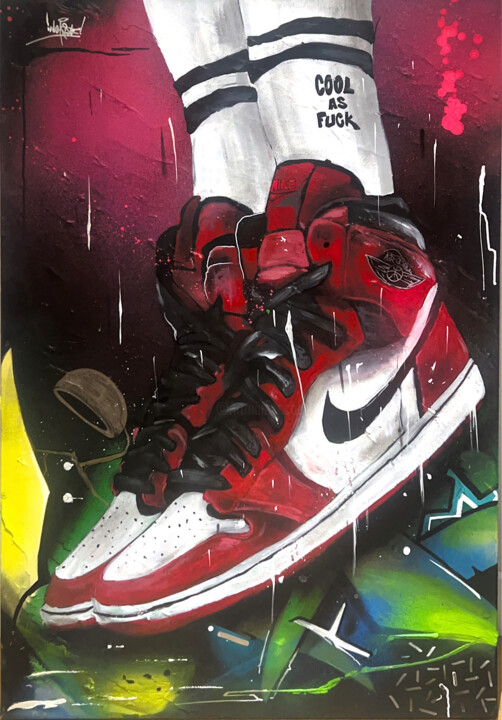
©2024 Ynoxe
Entwicklungen dieser zeitgenössischen Werke auf dem Kunstmarkt
Während wir uns durch das 21. Jahrhundert navigieren, entwickelt sich und erweitert sich die dynamische Landschaft der zeitgenössischen Kunst weiter und spiegelt unsere sich ständig verändernde Welt wider. Zeitgenössische Gemälde, einst hauptsächlich auf zwei dimensionale Leinwände beschränkt, umfassen nun eine Vielzahl von Formen und Techniken, von Multimedia-Installationen bis hin zu digitalen Kreationen, wobei jeder Teil ein reiches Geflecht aus Gedanken, Emotionen und Geschichten darstellt. Auch die Skulptur hat weitgehend die traditionellen Materialien wie Stein und Bronze überschritten, wobei Künstler Licht, Ton und sogar Bewegung einbeziehen und damit die Vergänglichkeit und den Fluss der modernen Welt verkörpern.
Die Fotografie hat in den Händen von zeitgenössischen Künstlern ihre Horizonte erweitert und sich nahtlos mit digitaler Technologie vermischt, um atemberaubende Bilder zu schaffen, die unsere Wahrnehmung der Realität in Frage stellen. Die Zeichnung hat ihrerseits die Grenzen des Papiers überschritten und multimediale Elemente und explorative Techniken integriert, um ihre Rolle im künstlerischen Diskurs neu zu definieren. Die Gravur blüht weiterhin, wobei Zeitgenössische Künstler traditionelle Methoden innovativ nutzen, um starke soziale und persönliche Kommentare zu liefern.
Textilkunst, früher als Handwerk betrachtet, spielt heute eine wichtige Rolle in der Welt der zeitgenössischen Kunst, da Künstler sie nutzen, um Fragen der Identität, Tradition und des kulturellen Erbes zu erforschen. In der Zwischenzeit hat die digitale Kunst, das neueste Mitglied der Familie der zeitgenössischen Kunst, die Art und Weise, wie wir Kunst schaffen und interagieren, revolutioniert und immersive Erfahrungen geboten, die die Grenze zwischen virtuell und physisch verwischen.
Diese verschiedenen Formen der zeitgenössischen Kunst haben einen bedeutenden Wert auf dem heutigen Kunstmarkt, nicht nur aufgrund ihrer ästhetischen Anziehungskraft, sondern auch aufgrund ihrer Fähigkeit, komplexe Ideen und Emotionen zu verkapseln und zu kommunizieren. Sammler, Kuratoren und Kunstliebhaber aus der ganzen Welt suchen nach diesen Werken, angezogen von ihrem intrinsischen Dynamismus, ihrer innovativen Verwendung von Materialien und ihren eloquenten Ausdrucksformen unserer geteilten menschlichen Erfahrung. Als Zeugnis unserer Zeit verkapseln diese zeitgenössischen Kunstwerke den Impuls unserer Gesellschaft und die Resonanz individueller Stimmen und gravieren unsere kollektive Erzählung für immer in die Annalen der Kunstgeschichte ein.
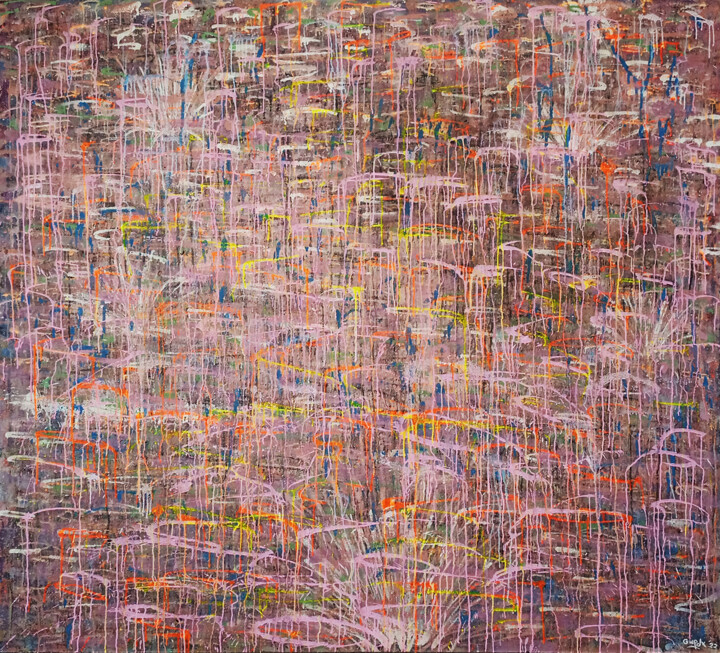
©2022 Giuseppe Valia
Berühmte zeitgenössische Künstler
Während wir in die vibrierende Welt der zeitgenössischen Kunst eintauchen, begegnen wir einer Vielzahl von Künstlern, die dieses dynamische Feld gestalten. Jeder von ihnen ist ein Meister in seinem Medium - Malerei, Skulptur, Fotografie, Zeichnung, Druckgrafik, Textil oder digitale Kunst - sie erweitern die künstlerischen Grenzen und spiegeln unsere Zeit wider und hinterfragen unsere Wahrnehmungen. Lassen Sie uns diese bemerkenswerten Beiträger und ihre revolutionären Werke erkunden.
1. Gerhard Richter - Bekannt für seinen facettenreichen Ansatz in der Malerei, fordert Richter die Grenzen des Mediums heraus und wechselt geschickt zwischen abstrakten und hyperrealistischen Stilen. Seine Werke, ob sie nun mit einem Spachtel gestreckte Pigmente oder unscharfe fotografische Bilder zeigen, führen einen faszinierenden Dialog mit der Wahrnehmung.
2. Jeff Koons - Ein wichtiger Vertreter der zeitgenössischen Skulptur, Koons schafft monumentale Werke, die Themen wie Konsum, Geschmack und Popkultur erforschen. Seine ikonischen Ballontiere, die aus spiegelglänzendem Edelstahl gefertigt sind, begeistern durch ihre sowohl spielerische als auch tiefgründige Aussage.
3. Cindy Sherman - Eine renommierte Fotografin, die ihr Objektiv nutzt, um Identität und soziale Rollen zu erforschen, insbesondere die von Frauen. Bekannt für ihre konzeptionellen Selbstporträts, übernimmt sie eine Vielzahl von Charakteren und erweitert die Grenzen der Fotografie als künstlerischen Ausdrucksform.
4. David Hockney - Hockney, mit einer umfangreichen Produktion über sechs Jahrzehnte hinweg, ist eine Schlüsselfigur der zeitgenössischen Zeichenkunst. Sein kühner Einsatz von Farbe und seine spielerische Erkundung der Perspektive vermitteln ein berauschendes Gefühl von Freude und eine uneingeschränkte Feier des Lebens.
5. Kiki Smith - Eine innovative Graveurin, Smiths Arbeit erforscht den menschlichen Zustand, insbesondere den weiblichen Körper und seine sozialen und kulturellen Konnotationen. Ihre Kupferstiche und Lithografien rufen universelle Erfahrungen des Lebens, des Todes und der Transformation hervor.
6. El Anatsui - Als Meister der Textilkunst schafft Anatsui wunderschöne Installationen, die aus weggeworfenen Flaschenverschlüssen und Aluminiumstücken wie Wandteppiche aussehen. Diese flexiblen und glitzernden Skulpturen vereinen traditionelle afrikanische Ästhetik und zeitgenössische künstlerische Sensibilität und behandeln Themen wie Konsum, Abfall und die Vernetztheit unserer Welt.
7. Rafael Lozano-Hemmer - Eine herausragende Persönlichkeit der digitalen Kunst, Lozano-Hemmer nutzt Technologie, um interaktive Installationen zu schaffen, die Architektur und Performance-Kunst kombinieren. Seine oft partizipativen Arbeiten erforschen Themen wie Überwachung, Privatsphäre und die Beziehung zwischen Menschen und ihrer Umwelt.
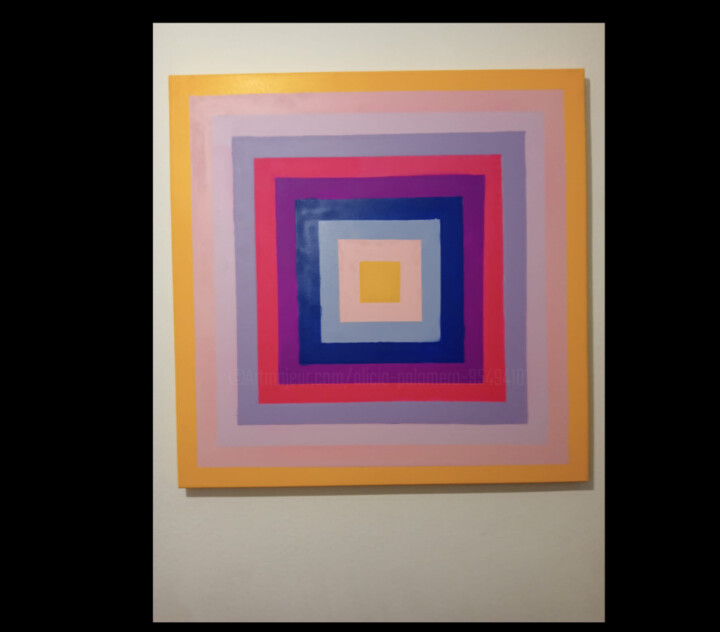
©2020 Alicia Palomero Künstler von Iberoamerica Art Gallery vertreten
Bemerkenswerte zeitgenössische Kunstwerke
Das Panorama der zeitgenössischen Kunst ist ein dynamisches Patchwork aus verschiedenen Ausdrucksformen und innovativen Ideen, wobei jedes Werk einen einzigartigen Dialog mit seinem Publikum darstellt. Hier ist eine Auswahl renommierter zeitgenössischer Kunstwerke, die verschiedene Medien wie Malerei, Skulptur, Fotografie, Zeichnung, Druckgrafik, Textilkunst und digitale Kunst umfassen und diese lebhafte Bewegung tiefgreifend beeinflusst haben.
Diese Werke, in ihrer Vielfalt, illustrieren das reichhaltige Muster der zeitgenössischen Kunst, wobei jedes Stück ein einzigartiger Kommentar über unsere Welt und ein Zeugnis des unbegrenzten Potenzials kreativen Ausdrucks ist.
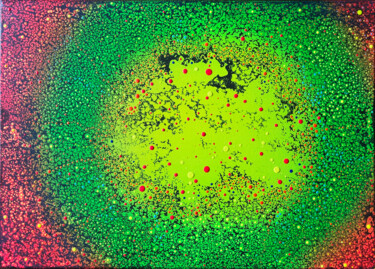
Mat 1618
Sprühfarbe auf Leinwand | 19,7x27,6 in
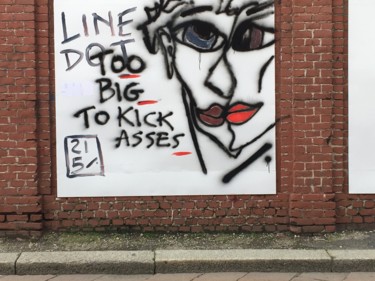
Linedot
Sprühfarbe auf Kunststoffplatte | 118,1x118,1 in
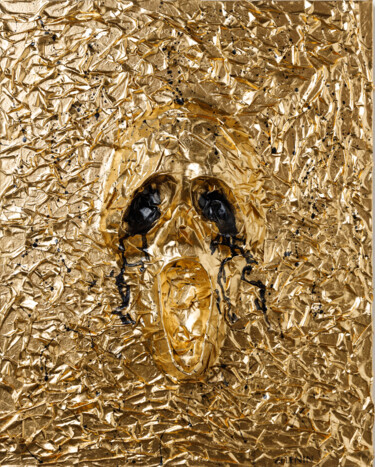
Zelenin
Sprühfarbe auf Leinen Leinwand | 19,7x15,8 in
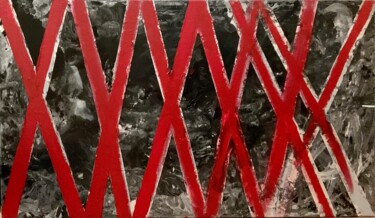
Séverine Pilloud (SEVE Art Visions)
Sprühfarbe auf Leinwand | 27,6x47,2 in


